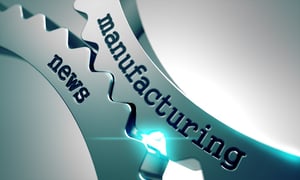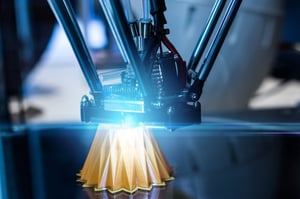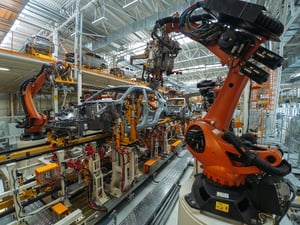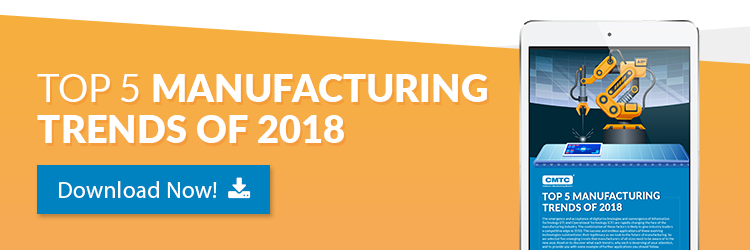December 12, 2018 | Exporting, Manufacturing Technology, Sustainable Manufacturing, Additive Manufacturing, Robotics & Automation
Today's Top 6 Manufacturing Topics
 The manufacturing industry has been making rapid advancements in recent years, paving the way for cutting-edge technologies. With each new innovation, manufacturing gets more efficient and more precise, leading to the cost-effective production of safer and higher-quality products. But despite common perception, not all advancements are just for the manufacturing giants; today, many small and medium-sized manufacturers (SMMs) are able to take advantage of them too. Here’s a look at a handful of recent technologies and topics trending now within the manufacturing industry.
The manufacturing industry has been making rapid advancements in recent years, paving the way for cutting-edge technologies. With each new innovation, manufacturing gets more efficient and more precise, leading to the cost-effective production of safer and higher-quality products. But despite common perception, not all advancements are just for the manufacturing giants; today, many small and medium-sized manufacturers (SMMs) are able to take advantage of them too. Here’s a look at a handful of recent technologies and topics trending now within the manufacturing industry.
Six Manufacturing Trends Happening Now
1. Additive Manufacturing
 Also known as 3D printing, additive manufacturing and metal additive manufacturing are using simple digital files to bring real structures to life, layer-by-layer. This innovative manufacturing technology was first conceived in the 1980s, but it has not been until recently that its true abilities have been realized. Now, it’s transforming the methods manufacturers use to create various parts and products and the industries that have embraced it are witnessing tremendous benefits.
Also known as 3D printing, additive manufacturing and metal additive manufacturing are using simple digital files to bring real structures to life, layer-by-layer. This innovative manufacturing technology was first conceived in the 1980s, but it has not been until recently that its true abilities have been realized. Now, it’s transforming the methods manufacturers use to create various parts and products and the industries that have embraced it are witnessing tremendous benefits.
For many years, the cost of additive equipment was just too expensive for SMMs to consider purchasing. But new technologies have changed that, making the cost of entry much more affordable and cutting equipment prices to as low as $3,500 for a reliable industrial-quality machine. In addition, additive manufacturing has the ability to reduce energy costs and the amount of capital needed to scale up production without making major changes, allowing SMMs to increase the speed and profitability of their business model.
That’s not all. Additive manufacturing generates significantly less waste than traditional manufacturing methods, adding layers to create something versus removing layers; it’s been known to reduce material costs and waste by as much as 90%.
Learn more about the benefits of additive marketing here.
2. Advanced Robotics and Automation
 Robotics has come a long way from when it first hit factory floors in the early 1960s. Today’s robots are more intelligent and versatile, and able to work with little or no human intervention. The result is greater workplace safety (leave the dangerous jobs to the bots!), greater efficiency, and an increased ability for SMMs to compete with the big guys. “Automate or evaporate,” says Dr. Howie Choset of the Advanced Robotics Manufacturing Institute (ARM), which emphasizes the importance of automation with robotics for small companies. “[Small companies that] don’t embrace automation will not be around in the future.” To help manufacturers embrace robotics, ARM is heavily investing in not just the technology, but the training of workers.
Robotics has come a long way from when it first hit factory floors in the early 1960s. Today’s robots are more intelligent and versatile, and able to work with little or no human intervention. The result is greater workplace safety (leave the dangerous jobs to the bots!), greater efficiency, and an increased ability for SMMs to compete with the big guys. “Automate or evaporate,” says Dr. Howie Choset of the Advanced Robotics Manufacturing Institute (ARM), which emphasizes the importance of automation with robotics for small companies. “[Small companies that] don’t embrace automation will not be around in the future.” To help manufacturers embrace robotics, ARM is heavily investing in not just the technology, but the training of workers.
Even better news? SMMs that previously couldn’t afford robotics and automation are increasingly finding positive ROI as the cost of automation falls and the ease of use rises. Now, teaming human workers with robots on the assembly line is fundamentally changing how SMMs manufacture their products. And when it comes to job concerns, recent studies have shown that the use of robotics and automation is actually helping boost productivity rather than reduce jobs. With analysts predicting that the industrial robotics market will nearly triple in less than ten years—with smarter, safer collaborative robots (“cobots”) making up a large part of that—there is no better time for manufacturers to get in the robotics game.
Want to learn more about robotics in manufacturing? Click here.
3. Exporting in California
 Exporting is big business in the Golden State, which exports to 230 foreign markets generating over $170 billion last year alone. For manufacturers, exporting makes sense; after all, 95% of the world’s market lies outside the US, and competition within US borders is becoming more intense every day. But it’s not just manufacturing giants that are making their way to Canada, Mexico, and overseas; in fact, 97% of goods exported are shipped by small and medium-sized companies.
Exporting is big business in the Golden State, which exports to 230 foreign markets generating over $170 billion last year alone. For manufacturers, exporting makes sense; after all, 95% of the world’s market lies outside the US, and competition within US borders is becoming more intense every day. But it’s not just manufacturing giants that are making their way to Canada, Mexico, and overseas; in fact, 97% of goods exported are shipped by small and medium-sized companies.
Of course, getting started can be a daunting task, from selecting the right global market to complying with regulatory and legal issues. That’s why California’s small and medium-sized manufacturers are turning to ExporTech™. A collaboration between the Manufacturing Extension Partnership (MEP), the U.S. Commercial Service, and a variety of regional partners, ExporTech has been helping manufacturers enter or expand into global markets since 2006—and they can do the same for you.
Learn more about ExporTech and how the program works here.
4. Flexible Hybrid Electronics
 Combining elements of the electronics and precision printing industries, Flexible Hybrid Electronics (FHE) is making it possible to create lightweight, flexible devices (consider this: a smartphone that folds like an early 00’s flip phone). The beauty of FHE is its ability to bend and stretch across the shape of a person, an object, or structure while maintaining the full operational integrity of a traditional electronic architecture.
Combining elements of the electronics and precision printing industries, Flexible Hybrid Electronics (FHE) is making it possible to create lightweight, flexible devices (consider this: a smartphone that folds like an early 00’s flip phone). The beauty of FHE is its ability to bend and stretch across the shape of a person, an object, or structure while maintaining the full operational integrity of a traditional electronic architecture.
With FHE poised to take the industry by storm, a consortium of companies, academic institutions, non-profits, and state, local and federal governments known as NextFlex was formed. Their goal is to advance US manufacturing of FHE, creating new uses for FHE and ushering in an era of “electronics on everything” to advance efficiency in our world.
Learn more about FHE and its exciting 21st century application here.
5. Nanomanufacturing
 First thing’s first: what is a nano? One nano is equivalent to a billionth of a meter; it’s to a meter what a football is to the entire earth. Nanotechnology involves manipulating materials at the nano-level. Nanomanufacturing, then, involves improving or building products more cost-effectively with fewer imperfections and greater durability. This is accomplished through one of two approaches:
First thing’s first: what is a nano? One nano is equivalent to a billionth of a meter; it’s to a meter what a football is to the entire earth. Nanotechnology involves manipulating materials at the nano-level. Nanomanufacturing, then, involves improving or building products more cost-effectively with fewer imperfections and greater durability. This is accomplished through one of two approaches:
-
Top-down. Reducing large pieces of material down to the nanoscale (think of it as carving a small figurine from a large block of wood).
-
Bottom-up. Creating products by building them up from atomic and molecular scale components (less wasteful than top-down, but more time-consuming).
While nanomanufacturing is used mostly in space technology and biotechnology, it’s gaining momentum in other areas of manufacturing: nanocomposites are being used in the production of car parts and golf clubs; nanoparticles are producing stain-resistant apparel and rocket propellants; and nanostructured materials are cutting superior drill bits and jet engine parts.
Read more about this exciting new technology here.
6. Sustainable Manufacturing
 Whereas going green tends to refer to improving a specific component of the manufacturing process that will benefit the environment—say, using recycled materials—sustainable manufacturing takes a holistic approach to environmental responsibility, taking the entire manufacturing process, including logistics, into account. Sustainable manufacturing also isn’t just about doing the planet a favor (though it does), it’s also about minimizing energy use and the costs associated with it while maximizing production.
Whereas going green tends to refer to improving a specific component of the manufacturing process that will benefit the environment—say, using recycled materials—sustainable manufacturing takes a holistic approach to environmental responsibility, taking the entire manufacturing process, including logistics, into account. Sustainable manufacturing also isn’t just about doing the planet a favor (though it does), it’s also about minimizing energy use and the costs associated with it while maximizing production.
Some of the ways manufacturers practice sustainable manufacturing include reducing harmful emissions, harvesting solar and wind energy, installing energy-efficient lighting, equipment, and machinery, recycling, going paperless, finding more efficient transportation routes, and even building sustainable factories from the ground-up using intelligent robotic systems.
The benefits don’t stop there. Manufacturers practicing sustainability often receive tax incentives at the federal and state level, and consumers and new recruits are increasingly seeking out sustainable products and companies (while criticizing those who don’t engage in these practices through social media).
The Future Is Now
From the precision in the products we create to the places we’re able to export them to, advancements in technology have changed the face of manufacturing. While change can be frightening at times, these advancements should be embraced, not feared. They’re making the manufacturing space safer and more efficient, helping save the planet (and money), and enabling US manufacturers to better compete with companies overseas. We’ll continue to keep you up-to-date on the latest advancements in the industry, so be sure to subscribe to our blog if you haven’t already.


Leave a Comment